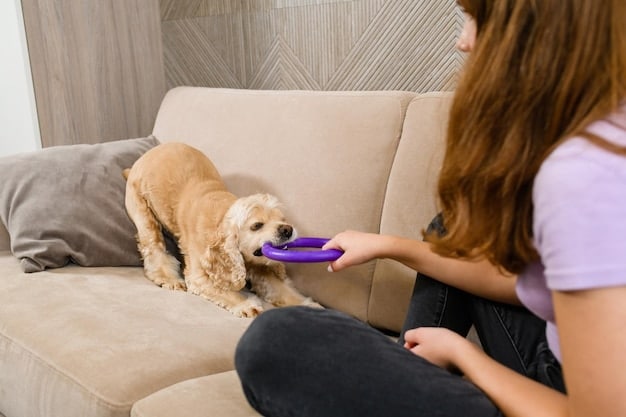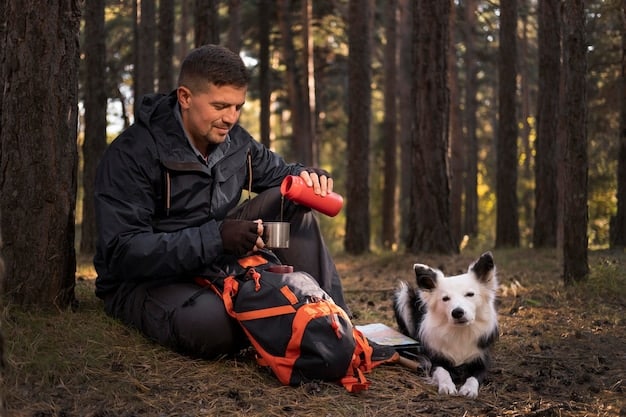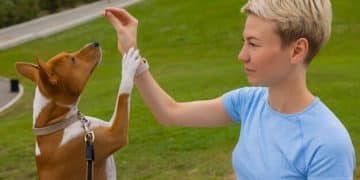Clicker Training 101: Your Guide to a Happier, Smarter Dog

Anúncios
Clicker Training 101 is a positive reinforcement technique using a distinct clicking sound to mark desired behaviors, making training more effective and enjoyable for both you and your dog by clearly communicating what actions earn rewards.
Unlock your dog’s full potential with clicker training 101, a powerful and positive method that transforms training into a fun and rewarding experience for both you and your furry friend.
Anúncios
What is Clicker Training and Why Use It?
Clicker training is a popular and effective method of dog training that relies on positive reinforcement. Instead of using punishment or force, it utilizes a unique sound – the ‘click’ – to mark the exact moment your dog performs a desired behavior. This precise timing helps your dog quickly understand what you’re asking of them.
But why choose clicker training over other methods? Let’s delve into the benefits.
Anúncios
The Science Behind the Click
The clicker acts as a bridge between the desired behavior and the reward. It creates a clear association in your dog’s mind, making the learning process faster and more efficient. This is because the click sound is consistent and distinct, unlike verbal praise which can vary in tone and inflection.
Benefits of Clicker Training
Clicker training offers several advantages over traditional training techniques.
- Improved Communication: The clicker provides crystal-clear communication, eliminating confusion and frustration for your dog.
- Positive Reinforcement: It focuses on rewarding good behavior, creating a positive and enjoyable training experience, strengthening the bond between you and your dog.
- Faster Learning: The precise timing of the click helps dogs learn new commands and tricks more quickly.
- Versatility: Clicker training can be used to teach a wide range of behaviors, from basic obedience to complex tricks.
Ultimately, clicker training fosters a more cooperative and engaged partnership with your dog, making training a positive experience for everyone involved.
Getting Started: Essential Equipment and Preparation
Before you dive into clicker training, you’ll need a few essential items to get started. Don’t worry, the setup is simple and affordable, ensuring you and your dog can embark on this exciting journey with ease.
Here’s what you’ll need:
The Clicker
The most important piece of equipment is, of course, the clicker itself. Choose a clicker that is comfortable to hold and produces a clear, consistent clicking sound. There are many different types available, so find one that suits your preferences.
High-Value Treats
Treats are your dog’s reward for performing the desired behavior. The treats should be small, soft, and highly palatable to your dog. Experiment to find what motivates your dog the most. Options include small pieces of cheese, cooked chicken, or commercial dog treats.
A Quiet Training Environment
Start training in a quiet environment with minimal distractions. This will help your dog focus on you and the task at hand. As your dog progresses, you can gradually introduce distractions.

Preparing Your Dog
Before you begin, it’s crucial your dog understands the clicker’s significance. Here’s how to introduce the clicker:
- Charge the Clicker: Pair the click with a treat. Click, then immediately give your dog a treat. Repeat this several times until your dog associates the click with something positive.
- Keep Sessions Short: Start with short, 5-10 minute training sessions to keep your dog engaged and prevent them from becoming overwhelmed.
With the right equipment and a little preparation, you’ll be well on your way to successful clicker training.
Mastering the Basics: Click and Reward Timing
One of the most crucial aspects of clicker training is mastering the timing of the click. The clicker must be used to mark the precise moment your dog performs the desired behavior. The timing is essential because the click sound signals to the dog **this** is the behavior that is being rewarded.
Let’s break down the key element of timing:
Mark the Behavior, Not the Action After
The click should occur while your dog is performing the desired behavior, not after they have finished. For example, if you are teaching your dog to sit, click the moment their rear touches the ground.
The Click is a Promise
The click is a promise that a reward is coming. Always follow the click with a treat, even if your dog doesn’t perform the behavior perfectly. The goal is to create a positive association with the clicker.
Consistency is Key
Be consistent with your timing and your rewards. This will help your dog learn more quickly and avoid confusion. Use the same clicking sound every time, and always follow the click with a treat.
- Immediate Reward: Deliver the reward within a few seconds of the click. This reinforces the connection between the behavior, the click, and the treat.
- Avoid Luring: Use the clicker to mark the behavior, not to lure your dog into position. Luring can create dependency on the lure, hindering independent performance.
By mastering the art of click and reward timing, you’ll be well-equipped to teach your dog a wide range of behaviors with ease and efficiency. Perfect timing makes all the difference.
Shaping Behaviors: Breaking Down Complex Tasks
Shaping is a technique used in clicker training to teach complex behaviors by breaking them down into smaller, more manageable steps. It involves rewarding successive approximations of the desired behavior until the dog eventually performs the complete action.
By using shaping, you’re essentially guiding your dog to the desired end result.
How to Shape a Behavior
Here’s a step-by-step guide to shaping:
- Define the Target Behavior: Clearly define the end goal. What do you want your dog to ultimately do?
- Break it Down: Divide the target behavior into smaller, incremental steps.
- Reward Successive Approximations: Start by rewarding any behavior that resembles the desired end result, then gradually raise the bar as your dog progresses.
- Click and Treat: Remember to click and treat for each successful approximation.
Example: Teaching “Fetch”
Let’s say you want to teach your dog to fetch. Here’s how you might break it down using shaping:
- Step 1: Reward your dog for looking at the toy.
- Step 2: Reward your dog for moving towards the toy.
- Step 3: Reward your dog for touching the toy with their nose.
- Step 4: Reward your dog for picking up the toy.
- Step 5: Reward your dog for taking a step towards you with the toy.
- Step 6: Reward your dog for bringing the toy all the way back to you.

Tips for Successful Shaping
Keep these tips in mind when using shaping:
- Be Patient: Shaping takes time and patience. Don’t get discouraged if your dog doesn’t learn the behavior immediately.
- Keep Sessions Short: Short, frequent sessions are more effective than long, infrequent ones.
- End on a Positive Note: Always end each session with a behavior your dog knows well.
Shaping can be a powerful tool for teaching your dog complex behaviors, fostering patience and rewarding progress along the way.
Troubleshooting Common Clicker Training Challenges
While clicker training is generally effective, you may encounter some challenges along the way. Here are some common issues and how to address them, ensuring a smoother learning curve for both you and your canine companion.
Understanding these common challenges can make your journey more enjoyable and effective.
Dog Not Motivated by Treats
If your dog isn’t motivated by treats, try different types of treats. Some dogs prefer high-value treats like cooked chicken or cheese. You can also try using a toy as a reward, especially for dogs who are toy-driven.
Dog Gets Too Excited
If your dog gets too excited during training, take a break and let them calm down. You can also try using a lower-value treat or rewarding calmer behavior. Reduce the intensity and duration of the sessions.
Dog Doesn’t Understand the Clicker
Make sure your dog understands the association between the clicker and the reward. Spend some time simply clicking and treating to establish this connection. If needed repeat the ‘charging’ process described earlier.
Dog Starts Anticipating the Click
If your dog starts anticipating the click, they may start offering behaviors randomly in an attempt to get a reward. To combat this, vary your criteria and only click for the desired behavior.
- Distraction: Minimize distractions in your training environment, particularly in the initial stages. Gradually introduce distractions as your dog progresses.
- Consistency: Ensure everyone in the household uses the same commands and clicker training techniques to avoid confusing your dog.
By addressing these common challenges with patience and consistency, you can overcome obstacles and continue to enjoy the benefits of clicker training.
Advanced Clicker Training Techniques
Once your dog has mastered the basics of clicker training, you can explore more advanced techniques to further enhance their skills and abilities. These advanced techniques will not only make training more engaging but also strengthen the bond between you and your pet.
Here are a few advanced techniques to consider:
Capturing
Capturing involves clicking and rewarding behaviors that your dog offers spontaneously. This can be used to teach tricks or to shape desirable behaviors that your dog already exhibits. It relies on rewarding behaviors the dog already displays, so it’s great for confidence building.
Generalization
Generalization is the process of teaching your dog to perform a behavior in different environments and situations. Start by practicing the behavior in a quiet environment, then gradually introduce distractions and new locations.
Fading the Clicker
Once your dog consistently performs a behavior on cue, you can start to fade the clicker. This involves gradually reducing your reliance on the clicker, eventually replacing it with verbal praise or other rewards.
- Chain Behaviors: Link multiple behaviors together to create a sequence. This is a great way to challenge your dog mentally and physically.
- Variable Reinforcement: Vary the timing and frequency of rewards to keep your dog motivated and engaged. Sometimes reward every time, and sometimes every other time (or less).
By incorporating these advanced techniques into your training regimen, you can take your dog’s skills to the next level and unlock their full potential.
| Key Point | Brief Description |
|---|---|
| 🎯 Timing | Click precisely when the desired behavior occurs. |
| 🐾 Shaping | Break complex tasks into small, achievable steps. |
| 🏆 Rewards | Use high-value treats to motivate your dog effectively. |
| 🏞️ Generalization | Practice in various locations to ensure reliable behavior. |
FAQ
▼
You can start clicker training with your dog at any age! Puppies can begin learning basic commands as early as 8 weeks old, while older dogs can also benefit from this method. The key is to adapt the training to your dog’s individual needs and abilities.
▼
If your dog is scared of the clicker sound, you can try using a quieter clicker or muffling the sound by putting the clicker in your pocket or behind your back. You can also start by clicking at a distance and gradually moving closer as your dog gets more comfortable.
▼
Clicker training sessions should be short and frequent, ideally lasting no more than 5-10 minutes at a time. This will help keep your dog engaged and prevent them from becoming bored or overwhelmed. Aim for multiple short sessions throughout the day.
▼
Yes, clicker training can be used to teach all types of behaviors, from basic obedience commands to complex tricks. It is a versatile and effective method that can be adapted to suit your dog’s individual needs and learning style. With patience you can teach almost anything!
▼
While the clicker is a valuable tool for marking desired behaviors, you don’t necessarily have to use it forever. Once your dog consistently performs a behavior on cue, you can start to fade the clicker and rely more on verbal praise and other rewards. It is there if you need it, however!
Conclusion
Clicker training 101 is a rewarding journey that enhances communication and strengthens the bond between you and your dog. By mastering the techniques and applying patience and consistency, you can unlock your dog’s potential and create a well-behaved and happy companion.






